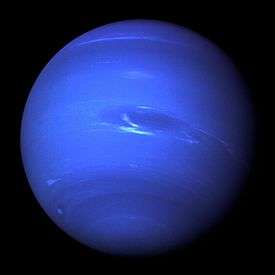William Lassell
| William Lassell | |
|---|---|
 | |
| Born |
18 June 1799 Bolton, England |
| Died |
5 October 1880 (aged 81) Maidenhead, England |
| Known for | Discovered the moons Triton, Hyperion, Ariel and Umbriel |
| Awards |
Gold Medal of the Royal Astronomical Society (1849) Royal Medal (1858) |
| Scientific career | |
| Fields | Astronomer |
William Lassell, FRS FRSE FRSL FRAS (18 June 1799 – 5 October 1880) was an English merchant and astronomer.[1][2][3][4][5][6] He is remembered for his improvements to the reflecting telescope and his ensuing discoveries of four planetary satellites.
Life
William Lassell was born in Bolton, Lancashire. He was educated first in Bolton then at Rochdale Academy.[7] After the death of his father, he was apprenticed from 1814 to 1821 to a merchant in Liverpool. He then made his fortune as a beer brewer, which enabled him to indulge his interest in astronomy. He built an observatory at his house "Starfield" in West Derby, a suburb of Liverpool. There he had a 24-inch (610 mm) reflector telescope, for which he pioneered the use of an equatorial mount for easy tracking of objects as the Earth rotates. He ground and polished the mirror himself, using equipment he constructed. The observatory was later (1854) moved further out of Liverpool, to Bradstone.
In 1846 Lassell discovered Triton, the largest moon of Neptune, just 17 days after the discovery of Neptune itself by German astronomer Johann Gottfried Galle.[8][9] In 1848 he independently co-discovered Hyperion, a moon of Saturn. In 1851 he discovered Ariel and Umbriel, two moons of Uranus.
In 1855, he built a 48-inch (1,200 mm) telescope, which he installed in Malta because of the observing conditions that were better than in often-overcast England. On his return to the UK after several years in Malta he moved to Maidenhead and operated his 24-inch (610 mm) telescope in an observatory there. The 48-inch telescope was dismantled and was eventually scrapped.[10]
Lassell was a Fellow of the Royal Astronomical Society (FRAS) from 1839, won the Gold Medal of the Royal Astronomical Society in 1849, and served as its president for two years starting in 1870.[11] He was elected a Fellow of the Royal Society (FRS) in 1849 and won their Royal Medal in 1858.[12] Lassel was also a Fellow of the Royal Society of Literature (FRSL).[13] He was furthermore elected an honorary Fellow of the Royal Society of Edinburgh (HonFRSE) and of the Society of Sciences of Upsala, and received an honorary LL.D. degree from the University of Cambridge in 1874.[14]
Lassell died in Maidenhead in 1880 and is buried at St. Luke's Church[15]. Upon his death, he left a fortune of £80,000 (roughly equivalent to £7,300,000 in 2016). His telescope was presented to the Royal Observatory in Greenwich.
The crater Lassell on the Moon, a crater on Mars, the asteroid 2636 Lassell and a ring of Neptune are named in his honour. At the University of Liverpool the William Lassell prize is awarded to the student with the highest grades graduating the B.Sc. program in Physics with Astronomy each year.[16][17]
References
- ↑

- ↑ AN 98(1881) 108 (in German)
- ↑ "William Lassell". Monthly Notices of the Royal Astronomical Society. Royal Astronomical Society. 41 (4): 188–191. 1881. Bibcode:1881MNRAS..41..188.. doi:10.1093/mnras/41.4.188. Retrieved 8 November 2015.
- ↑ Huggins, Margaret Lindsay (1880). "The late Mr. William Lassell, LL.D., F.R.S." The Observatory. 3 (43): 587–590. Retrieved 8 November 2015.
- ↑ "The Late Mr. Lassell". Astronomical Register. 18 (215): 284–285. 1880. Bibcode:1880AReg...18..284. Retrieved 8 November 2015.
- ↑ McFarland, John (2014). "Lassell, William". In Hockey, Thomas; Trimble, Virginia; Williams, Thomas R. Biographical Encyclopedia of Astronomers. New York: Springer Publishing. doi:10.1007/978-1-4419-9917-7_828. ISBN 978-1-4419-9917-7. Retrieved 8 November 2015.
- ↑ Biographical Index of Former Fellows of the Royal Society of Edinburgh 1783–2002 (PDF). The Royal Society of Edinburgh. July 2006. ISBN 0 902 198 84 X.
- ↑ Smith, Robert W. (1983). "William Lassell and the Discovery of Neptune". Journal for the History of Astronomy. Science History Publications Ltd. 14: 30–32. Bibcode:1983JHA....14...30S. Retrieved 14 November 2015.
- ↑ Smith, Robert W.; Baum, Richard (1984). "William Lassell and the Ring of Neptune: a Case Study in Instrumental Failure". Journal for the History of Astronomy. Science History Publications Ltd. 15 (1): 1–17. Bibcode:1984JHA....15....1S. Retrieved 14 November 2015.
- ↑ Lassell, William (1877). "Mr. Lassell's Great Reflector". The Observatory. 1 (6): 178–179. Bibcode:1877Obs.....1..178L. Retrieved 17 November 2015.
- ↑ Herschel, John (1850). "An Address Delivered at the Annual General Meeting of the Royal Astronomical Society, February 9, 1849, on Presenting the Honorary Medal to William Lassell, Esq. of Liverpool". Memoirs of the Royal Astronomical Society. London: Royal Astronomical Society. 18: 192–200. Bibcode:1850MmRAS..18..192H. Retrieved 14 November 2015.
- ↑ "Library and Archive Catalogue". Royal Society. Retrieved 30 December 2010.
- ↑ On a Method of Supporting a large Speculum, free from sensible Flexure, in all Positions - website Google Books
- ↑ Former Fellows of the Royal Society of Edinburgh 1783–2002 – website of the Royal Society of Edinburgh
- ↑ HistoryTrail.pdf (St. Luke's Chuch)
- ↑ "Physics Pre-Graduation Event 2017". Department of Physics, University of Liverpool. Retrieved 31 October 2017.
- ↑ "Congratulations to all of our 2014 Physics graduates". Department of Physics, University of Liverpool. Retrieved 31 October 2017.
External links
| Wikimedia Commons has media related to William Lassell. |
